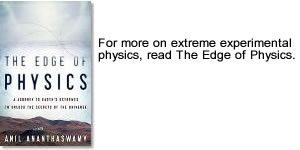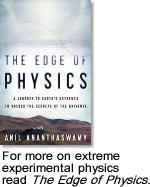Posts from — December 2009
FERMI supports decaying dark matter
NASA’s FERMI gamma-ray telescope is the sharpest tool in the sky for indirectly detecting the presence of dark matter. A new paper by Christoph Weniger of DESY and colleagues looks at the evidence from FERMI and compares it with data collected by the PAMELA satellite. Their conclusions are tantalising.
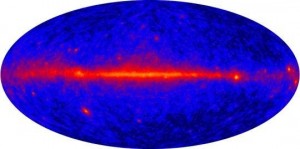
FERMI all sky survey. Credit: NASA/DOE/International LAT Team
It was evidence from PAMELA last year that got the dark matter community talking about this unseen component of the universe having finally been detected, albeit indirectly. PAMELA saw an increase in the positron fraction (which is the amount of positrons divided by the sum of positrons and electrons) for energies greater than 10 gigaelectronvolts. Now, there are no known primary sources of positrons, or anti-electrons, in space. That means that any positrons out there are the result of the collision of cosmic rays with interstellar gas. That leads to an expectation that the positron spectrum observed on Earth should “softer” than that of electrons. So, the positron fraction should decrease with increasing energy; but PAMELA observed the opposite.
This led to a flurry papers looking at the idea that the annihilation of dark matter particles was leading to the excess in the positron fraction.
But models based on the theoretician’s favourite dark matter particle — the neutralino — did not quite lead to what PAMELA was seeing out there.
Now, Weniger and colleagues are arguing that it’s not annihilation of dark matter particles, but the decaying of dark matter particles that should be examined. The decay will lead to electrons and positrons, which will in turn lead to the producton of gamma-rays via processes like Inverse Compton Scattering and bremsstrahlung emissions. Also, the decay will directly produce gamma-rays.
The physicists have analysed the gamma-ray data collected so far by FERMI, while taking into account the positron excess seen by PAMELA. Put these two together, and they have concluded that they cannot rule out models of decaying dark matter.
What kind of decaying dark matter could it be? They speculate of at least one: the gravitino that appears in supersymmetric models.
Keep tabs on further observations by FERMI: they will help test this hypothesis.
December 26, 2022 No Comments
Earth tides and the LHC
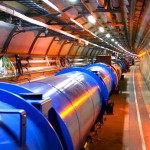
On 18 December, the heads of the various experiments at the Large Hadron Collider (ATLAS, CMS, ALICE and LHCb), and of the LHC itself, gave presentations at CERN, wrapping up things before the Christmas break. Steve Myers, director of accelerators and technology, concluded that “It has been a truly remarkable 24 days. Things have moved so quickly that it has been hard to keep up with the progress”.
One thing caught my eye in Myers’ presentation. The LHC team measured a predicted change in the beam energy due to Earth tides, within 10 days of the first beam circulating in the beam pipe.
This is a fascinating thing that was first measured during the days of the Large Electron Positron collider (which ran in the same tunnel that now houses the LHC). The gravitational pull of the sun and the moon change the shape of the Earth ever so slightly, predictably and periodically. But the LHC’s tunnel is so big (27 kilometres in circumference) that this change in Earth’s shape is enough to alter the length of the tunnel by 1 mm. This change can change the energy of the beam measurably.
Now, this has been seen in the LHC’s proton beam!
Here’s an illustration, courtesy of Steve Myers:
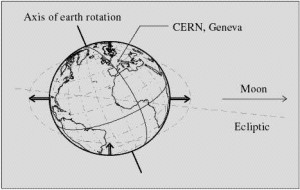
See here for the presentations at CERN.
December 22, 2022 No Comments
Dark matter detected?

A mural inside the Soudan Mine
The CDMS-II experiment, running inside the Soudan mine in Northern Minnesota, announced results of a 1000 kg-day run on Friday, 17 December. CDMS is one of the longest-running dark matter experiments, and certainly one of the front-runners in the race to directly detect dark matter. When the team opened their so-called black box — a term that describes the process of applying all the necessary cuts to exclude background noise to the data and completing the analysis before looking at the results — they were expecting to see 0.8 events, but instead they reported seeing 2.
Now, this is NOT statistically significant. Had they seen, say, 5 or more events more than what was expected, the case for a direct detection of dark matter would have been much stronger.
Still, the dark matter community is buzzing. This is one of the best results for those who have been toiling in the field for more than two decades searching for dark matter.
I can’t help but feel that the past year has seen a significant rise in the excitement surrounding dark matter. Space telescopes (PAMELA) and balloon experiments (ATIC) created news when they reported what could be interpreted as indirect detection of dark matter: the sightings of particles such as electrons and positrons in space coming from the annihilation of dark matter in our galaxy.
See the New Scientist story for more details.
Here are some pictures of the Soudan mine from my visit to see the CDMS experiment.
December 18, 2022 No Comments
Higgs in Space
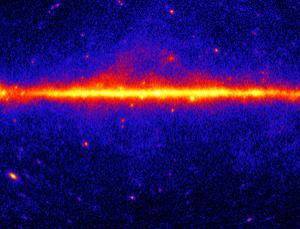
Gamma-rays from the galactic centre could contain signs of the Higgs (Image: NASA)
What a headline-grabbing title for a paper (http://arxiv.org/abs/0912.0004).
A tantalising idea that NASA’s FERMI telescope could end up seeing signatures of the Higgs, thanks to dark matter annihilations in space. There are, as usual, lots of caveats. Not least being the exotic model of dark matter that’s used in this paper. Still, very intriguing — and could potentially upstage the Large Hadron Collider in its search for the Higgs.
See my New Scientist article for more on this.
December 16, 2022 No Comments
Welcome
Hello Readers:
This blog will track the lastest developments in physics - especially in cosmology, particle physics and astroparticle physics. We wil also follow the experiments, telescopes and detectors that are discussed in my book The Edge of Physics.
Feel free to make comments here about the book and the blog posts.
-Anil
December 15, 2022 No Comments


